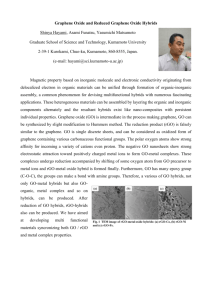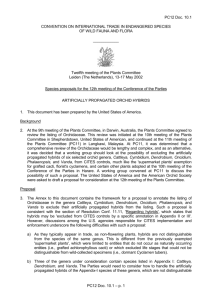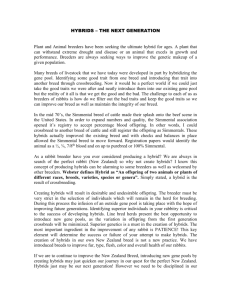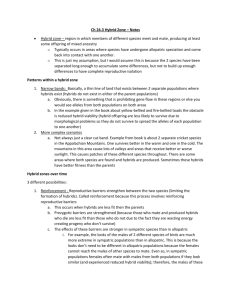UNIVERSITY OF AGRICULTURAL SCIENCE AND VETERINARY
advertisement
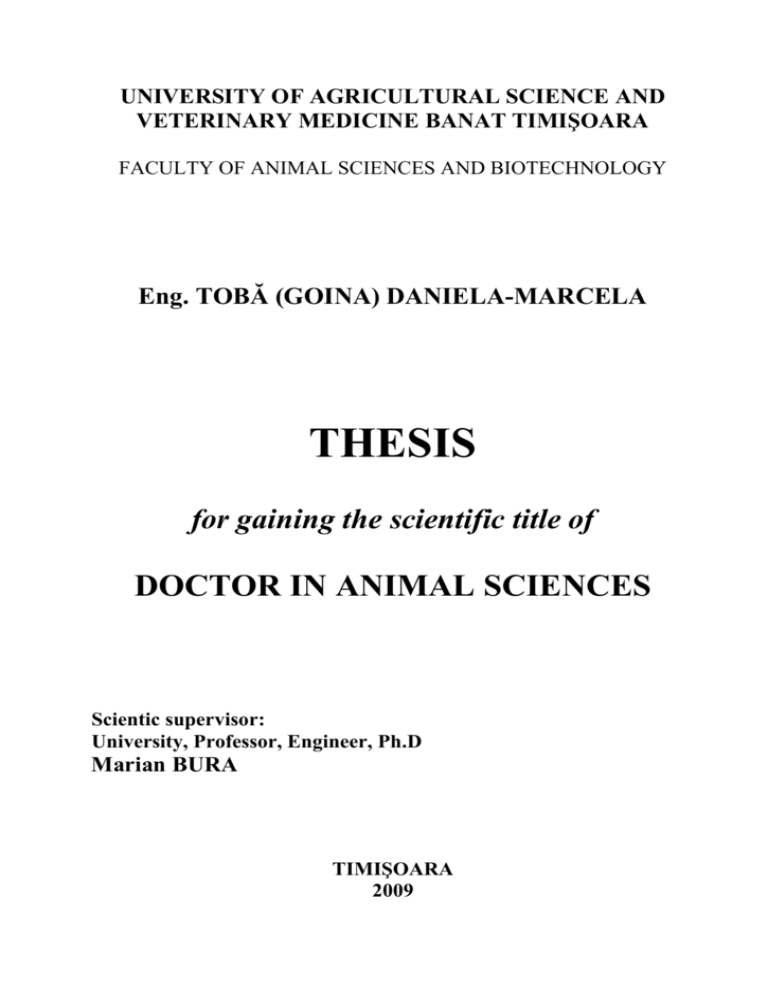
UNIVERSITY OF AGRICULTURAL SCIENCE AND VETERINARY MEDICINE BANAT TIMIŞOARA FACULTY OF ANIMAL SCIENCES AND BIOTECHNOLOGY Eng. TOBĂ (GOINA) DANIELA-MARCELA THESIS for gaining the scientific title of DOCTOR IN ANIMAL SCIENCES Scientic supervisor: University, Professor, Engineer, Ph.D Marian BURA TIMIŞOARA 2009 UNIVERSITY OF AGRICULTURAL SCIENCE AND VETERINARY MEDICINE BANAT TIMIŞOARA FACULTY OF ANIMAL SCIENCES AND BIOTECHNOLOGY Eng. TOBĂ (GOINA) DANIELA-MARCELA THESIS RESEARCH REGARDING THE HETEROSYS EFFECT IN THE PHENOTIPICAL EXPERSSION OF THE POTENTIAL PRODUCTIVITY FOR MEAT PRODUCTION TO THE RABBIT HYBRIDS Scientic supervisor: University, Professor, Engineer, Ph.D Marian BURA TIMIŞOARA 2009 THESIS RESUME RESEARCH REGARDING THE HETEROSYS EFFECT IN THE PHENOTIPICAL EXPERSSION OF THE POTENTIAL PRODUCTIVITY FOR MEAT PRODUCTION TO THE RABBIT HYBRIDS The rabbits have various zootechnic characteristics that are more advantageous comparing to another domestic animals species. A first advantage is represented by the fact that they can be breeds in small spaces. They breed and develop with cheap fodder that is easy to find. They replicate fast, the descendants have a fast rhythm to grow so they can turn account in a relatively short time period. The rabbit can easily satisfied the basic human requests, like: food through the meat and cloths through the fur and wool that they are providing. Also, produce manure for agriculture and it is very useful for laboratory and scientifically experiments. In the same time, the rabbit is the object of some of the sport’s hobbies [GEORGEONI et. al. 1984]. For those reasons, the volume of the rabbits productions, already appreciated in many countries, it is increasing in the entire world [Elena POPESCU-MICLOŞANU and Iuliana NEAGU, 2005]. If in 1975, the world rabbit meat production was estimated to about 120 00 tones, in 1992, this was around 300 000 tones [LEBAS and COLIN, 1994]. In Romania, in 1990, the rabbit meat production was 10625 tones, after that decreased very rapid, so in 2000 was 71.77% less and in 2007 was 97.5% less comparing to the 1990 production [after FAO, 2009 dates]. Our country, until 1999 exported rabbit meat mostly in Italy, France, Germany, but in 2003 the marker request for this product was achieved mostly from exports. The rabbit, because of his extraordinarily production and reproduction capacities can bring an important contribution in for the animal protein fight that is all over the world [BASELGA and GARCIA, 2002]. In the rabbits breeding, the genetically improvement papers have a high importance, because they hint the continuously production improvement and in the same time reduce the specific consumption and the costs per the product unit. Those papers include vast preoccupations for the maximal capitalization of the genetically potential of the present populations and to continuously increasing of this potential in the next generations, in the direction that the humans want [BURA and BENCSIK, 2000]. The PhD thesis it is named “RESEARCH REGARDING THE HETEROSYS EFFECT IN THE PHENOTIPICAL EXPERSSION OF THE POTENTIAL PRODUCTIVITY FOR MEAT PRODUCTION TO THE RABBIT HYBRIDS” elaborated by the PhD student TOBĂ (married GOINA) Daniela-Marcela, under the guidance of Prof. PhD. Eng. Marian Bura, it is compound from two parts, structured in 10 chapters and general conclusions, recommendations and bibliography. The thesis includes 224 pages, from those, the first part (The bibliography part) it is represented by 65 pages and the second part (Own researches) that is extended for 159 pages. The first part, BIBLIOGRAPHIC STUDY, is count from 3 chapters, structured as fallow: First chapter, THE IMPORTANCE OF THE RABBITS BREEDING, it is formed from 3 under chapters that are making reference to the importance of the rabbits breeding: economical importance of the rabbits breeding, the by-products and also the other benefits brought to the rabbit’s breeders. The second chapter, THE GENETICALLY IMPROVEMENT THROUGH CROSSING AND THE MEAT HYBRIDS PRODUCTION TECHNIQUE FOR RABBITS, were we treated the aspects that were regarding: the directions and the objectives in rabbits genetically improvement, the crossing improvement (improvement crossings, production crossings), the world meat hybrids production technique (the improving of the breeding characters, feed efficiency, carcass characters and final meat crossing). The third chapter, THE HETEROSYS EFFECT AND HIS USAGES IN RABBITS, included the study regarding the heterosys aspects: genetically and molecular aspects, theories and hypothesis, the terminology and the classification of the heterosys. In this chapter are presented the estimation methods for the heterosys phenomenon, the ways to obtain hybrids that will show heterosys and general ideas regarding the simple and the double hybrids. At the end of this chapter we talk about the simple and the double hybrids and were presented examples of rabbit hybrids that were obtained in the world. In the second part of this thesis, named OWN RESEARCHES, made from 6 chapters, we presented: In the fourth chapter it is presented the general organization of the researches, the goal of the paper, the experimental pattern that was used to achieve the proposed objectives, the materials and methods that were used to achieve the objectives, the resulted that were obtained and discussions that were obtained after the researches, general conclusions and recommendations for each chapter. On the base of the researches that were made we fallow to make more obvious the heterosys effect in the phonotypical expression of the hybrid rabbit meat production potential. The goal of the researches that we made was to use an experimental cross-breeding (combinative) scheme to determinate the optimal combinative capacity of six rabbit breeds that are frequently use in the small farms and peoples farm stead from Timiş county. For this we searched for: the crossing of two rabbit breeds with superior maternal features (prolificacy, fecundity, milking and body resistance capacity) to obtain F1 simple hybrids females; the crossing of the F1 hybrids female with males from breeds with superior paternal features (high growth gain, low specific feed consumption, good carcass quality) to produce the rabbits fated to be slaughtered. The biological material used in this research was represented by New Zealand White (NZW), Large Chinchilla (CHL), Californian (CAL) and the hybrids that were obtained after crossing those breeds, F1 simple hybrids (♀NZW x ♂CHL) and double three-breeds hybrids F2(♀F1x♂CAL). The parents of the pure breeds were purchased randomly from different rabbit breeders from Timiş county, at the optimal reproduction age, so they will be representatives for the populations that exist in this county. We have in considerations that all the rabbits were vaccinated and have no parasites. Also, we tuck in considerations that all the rabbits will come from farms with no infection contagious diseases, those conditions were certificated in the official origin and health papers. The total number of pure breeds rabbits that we study was 225 animals, from those 21 animals (5 females and 2 males for each pure breed) were purchased from farms from Timiş county, the rest of 204 animals were the result of the reproduction and multiplication process of the pure breeds animals from this experiment. By crossing the New Zealand White ♀ with Large Chinchilla ♂ we obtain 41 F1 hybrids (NZWxCHL). The F1 hybrids females (NZWxCHL) were crossed with Californian males, in this way we obtain the F2 (F1xCAL) hybrids. The total number of the F2 hybrids that we obtain and study in this experiment was 43 animals. In the fifth chapter are presented the COMPARATIVE RESEARCHES REGARDING THE OWN PERFORMANCES OF THE PURE BREEDS NEW ZEALAND WHITE, LARGE CHINCHILLA, CALIFORNIAN, SIMPLE F1 (♀NZWx♂CHL) HYBRIDS AND OF THE THREE-BREEDS F2 (♀F1x♂CAL) HYBRIDS DURING THE MILKING PERIOD. The researches have the goal to make a comparative study regarding the prolificacy of the rabbit groups that were study, the dynamic of the body mass of the descendants during the milking period, and also, the milking capacity of the females from those five experimental groups. The goal of this study was to establish the existence and also the size of the differences regarding the body mass during the milking period of the New Zealand White, Large Chinchilla and Californian descendants. Also, we fallow the heterosys effect regarding the body mass dynamic of the F1 hybrids that were obtained after crossing the New Zealand White with Large Chinchilla and the F2 hybrids that were obtained after crossing the F1 females with Californian males. Materials and methods. During the experiment, to establish the proposed indicators, we use the fallow methods: Establish the number of descendants that were obtained from each female/born, from each lot that was study. Establish the body mass of the rabbits during the milking period, for each lot that was study. To establish the weight of the litters we establish first the total body mass of the descendants from each litter, by scaling; To reduce as much as possible the stress caused by the handling, the average weight/descendant was established by scaling the entire litter and report to the number of descendants at: 7 days, 14 days, 21 days and 30 days (weaning). For that we use an electronic scale, with high accuracy, the scaling was made at the same moment and time for each experimental group. The results regarding the heterosys effect for prolificacy for the simple F1 (♀NZWx♂CHL) hybrids and F2 there-breeds double (♀F1x♂CAL) hybrids: The prolificacy for the New Zealand White was 7.91±0.34 descendants/born, for Large Chinchilla was 7.5±0.27 descendants/born, for Californian was 6.56±0.29 descendants/born. The prolificacy of the F1 (NZWxCHL) was 8.20±0.58 descendant/born, for the F2 this parameter was 8.60±0.68 descendant/born. The prolificacy heterosys for the lot made by the F1 (NZWxCHL) was 11.7%. The heterosys for the lot represented by the F2 animals was 14.18%. The results regarding the average weight of the litters (g) and the average body mass (g) during the milking period were study. The average weight of the F1 (NZWxCHL) hybrids litters at the born moment was 515.14±32.35 g, this value was over then the parental forms with 54.45 g comparing to the New Zealand White and 144.14 g comparing to the Large Chinchilla. The hybrids with the biggest average weight of the litter were represented by the F2 (F1xCAL), this was 527.60±41.39 g. The heterosys of the average weight of the litters at the born moment for the group represented by the F1 (NZWxCHL) hybrids was 19.27% and for the group represented by the F2 (F1xCAL) three-breeds double hybrids was 16.21%. The heterosys of the body mass of the descendants at born, determinate by the total weight of the litter at born, for the group made by the F1 (NZWxCHL) hybrids was 10.53% and for the F2 (F1xCAL) hybrids group was 8.17%. The heterosys of the average weight of the litter at the age of 7 days, for the group represented by the F1 (NZWxCHL) hybrids was 27.74% and for the F2 (F1xCAL) hybrids group was 16.22%. The heterosys of the body mass of the rabbit descendants at the age of 7 days for the group made by the F1 (NZWxCHL) hybrids was 19.66% and for the F2 (F1xCAL) hybrids group was 7.35%. The heterosys of the average weight of the litter at the age of 14 days, for the group represented by the F1 (NZWxCHL) hybrids was 27.20% and for the F2 (F1xCAL) hybrids group was 16.43%. The heterosys of the body mass of the rabbit descendants at the age of 14 days for the group made by the F1 (NZWxCHL) hybrids was 19.60% and for the F2 (F1xCAL) hybrids group was 6.24%. For both, F1 and F2 hybrids, at the age of 21 days, the average body mass of the litters registered heterosys effect that was 22.57%, respectively 14.31%. At weaning age (30 days), the heterosys for the weight of the litter for the group represented by the F1 (NZWxCHL) hybrids was 16.75% and for the F2 (F1xCAL) hybrids group was 2.3%. The F1 (NZWxCHL) hybrids descendants recorded a total gain of 536.43 g/animal with an average daily gain of 17.88 g/animal, this last value was over the maternal breed (New Zealand White) value with 8.66% and with 9.6% over the paternal breed (Large Chinchilla). For the F2 (F1xCAL) hybrids, the total gain was 539.85 g/animal during the entire milking period, with an average daily gain of 17.99 g/animal, over the parental breed with 0.61% comparing to the F1 (NZWxCHL) hybrids and over 3.33 comparing to Californian. In the same chapter was estimated the milking capacity of the females using the indirect method, starting from the idea that the average daily gain of the descendants in this period (0-21 days), expressed mainly in the mother milking capacity and tacking in consideration that for 1 gram of daily gain are necessary 1.82 grams of mother milk, after LEBAS [1971] and tacking in consideration that the phenotipical correlation (pc) between those two characters is 0.90. The milk production for both females breeds New Zealand White and F1 (NZWxCHL) hybrids, in those 3 weeks of milking had an ascendant trend. The maximum of milk quantity produced was registered in the last milking week (15-21 days), representing 42% from the total milk production of the New Zealand White breed and 40% for the F1 (NZWxCHL) hybrids females. For the F1 (NZWxCHL) hybrids females, that represented the maternal form of the hybrids F2 (F1xCAL), the milk production was 158.98±14.60 g for the 1-7 days, then increased to 273±16.73 g for the 8-14 days and the reached the value of 288.70±16.37 g for the 15-21 days period. The average daily milk production for the New Zealand White female was 128.13±19.02 g in the first 7 days of lactation, 209.02±5.35 for 8-14 days period and reached the maximum value 244.52±10.52 g in the last analyzed period (15-21 days). In the sixth chapter COMPARATIVE RESEARCHES REGARDING THE OWN PERFORMANCES OF THE INDIVIDS FROM THE NEW ZEALAND WHITE, LARGE CHINCHILLA, CALIFORNIAN, F1 (♀NZWx♂CHL) SIMPLE HYBRIDS AND ALSO OF THE F2 (♀F1x♀CAL) THREE-BREEDS DOUBLE HYBRIDS DURING THE FINISHING PERIOD. The goal of the research was to make obvious the heterosys effect in the phonotypical expression of the meat productive potential of the rabbits hybrids. The evaluation of the results of this research was made after establishing the indicators: the weigh at 60 days, 70 days and 80 days of the animals that were study with the purpose to establish the evolution of the body mass dynamic during the experimental period, the slaughtering of the animals at the age of 80 days allowed us to obtain information regarding the commercial carcass characteristics. In this experiment was determinate the average body weight of the rabbits from the five lots that were take in study, at the age of 60, 70 and 80 days, using an electronic scale, with high accuracy. In this way we establish if there were any significant differences between the groups regarding the growing and development characters, this difference being because of the different genetic structure of the animals. At the age of 60 days, the heterosys effect estimated regarding the average body mass of the young rabbits from the group represented by the F1 (NZWxCHL) hybrids was 83.58 g/animal, respectively 6.14%. For the F2 (F1xCAL) hybrids, the heterosys effect estimated regarding the average body mass was 154.78g, respectively 11.19%. At the age of 70 days, the average body mass of the young rabbits from the group represented by the F1 (NZWxCHL) hybrids was 1753.58 g/animal, with 3.72% smaller then the F2 (F1xCAL) hybrids an dwith 2.24% smaller then the one that was registered for the New Zealand White rabbits, with 12.25% bigger then the one from Large Chinchilla and with 10.26% bigger then the one registered for the Californian rabbits. The estimated heterosys effect was 5.00% for the F1 (NZWxCHL) hybrids and 8.66% for the F2 (F1xCAL) hybrids. The average body mass at slaughtering time it is important for it self and for the age when the slaughtering it is made. It is wished that the weight to be 2.4-2.5 kg (50-605 from the adult weight), when the rabbits will be slaughtered, to the achieved a early as possible (70-80 days) [BURA și BENCSIK, 2000]. The highest value of the body mass calculate for the young rabbits at the age of 80 days (slaughtering age), was recorded for the F2 (F1xCAL) hybrids, being 2203.70±22.23 g/animal. The average body mass of the F1 (NZWxCHL) hybrids was 2191.95±18.50 g/animal, with 0.53% smaller then the F2 (F1xCAL) hybrids. Comparing to the average body mass of the rabbits from New Zealand White , at this age, the F1 (NZWxCHL) hybrids were having a 121.87 g/animal higher body mass, and comparing to the Large Chinchilla 98.72 g/animal higher body mass. The average body mass heterosys of the your rabbits at the age of 80 days for the group represented by the F1 (NZWxCHL) hybrids was 5.53%, and 4.41% for the group represented by the F2 (F1xCAL) hybrids. At the end of the finishing period, we calculate the total gain and the average daily gain registered by the young rabbits from the five experimental groups. The estimated heterosys effect regarding the average daily gain for the finishing period fof the young rabbits from the group made by the F1 (NZWxCHL) hybrids was 1.09 g/animal, respectively 3.42$, for the group represented by the F2(F1xCAL) hybrids was 1.67 g/animal, respectively 5.21%. The seventh chapter COMPARATIVE RESEARCHES REGARDING THE RABBIT CARCASS COMERCIAL CHARACTERISTICS FOR THE WHITE NEOZEELANDEZ, LARGE CHINCHILLA, CALIFORNIAN, F1 (♂NZWx♀CHL) SIMPLE HYBRIDS AND F2 (♀F1x♂CAL) THREE-BREEDS DOUBLE HYBRIDS Hybridation is thee main way to determinate the heterosys effect. This method is tight up with the existence of the non additives gene interactions and by the high hereditary diversity between the group that are crossed. All the characters that have high hereditary transmission (have a high heritability coefficient) are reacting just a little for the heterosys, but the characters that have low heritability coefficient (fertility, viability, the growth rhythm) show and obvious heterosys, their variability is determinate mainly because of the non additive causes. The goal of this study was to establish the existence of the heterosys effect regarding the carcass characters of the rabbit’s hybrids. At the end of the finishing period (80 days), from each experimental group were choice 10 animals (50 animals totally) that were slaughtered with the purpose to establish some of the main commercial characters of the carcass. The results that we obtain were centralized and statistically analyzed. In this way we establish if there were any significant differences between the groups regarding the main commercial characters of the carcass, those differences being because of the different genetically structure of the animals. The average weight of the rabbits that should to be slaughtered at the age of 80 days was: 2144±20.88 g/animal for the New Zealand White; 2151±20.88 g/animal for the Large Chinchilla; 2030.45±36.10 g/animal for the Californian; 2192.27±28.74 g/animal for the F1 (NZWxCHL) hybrids; 2279.79±22.63 g/animal for the F2 (F1xCAL) hybrids. The average weight of the carcass without the head was 1170.99±19.04 g/animal for the New Zealand White; 1217.89±28.35 g/animal for the Large Chinchilla; with 4% more then for New Zealand White. For the Californian, the weight was 1077.84±40.64 g/animal. For the F1 (NZWxCHL) hybrids the average weight of the carcass without the head was 1232.64±29.24 g/animal and 1312.26±18.06 g/animal for the F2 (F1xCAL) hybrids. Having the numbers that were write bellow, regarding the live weight of the animals and those regarding the carcass weight, we determinate the slaughtering efficaciousness. The F1 (NZWxCHL) hybrids registered a 56.11% slaughtering efficaciousness and the F2 (F1xCAL) hybrids registered a 57.75% slaughtering efficaciousness. The heterosys effect that was estimated for this character of the rabbits from the F1 (NZWxCHL) group was 0.33% and for the rabbits from the F2 (F1xCAL) hybrids was 2.665%. In the eighth chapter RESEARCHES REGARDING THE QUANTITY AND QUALITY OF THE SPERM PRODUCE BY THE RABBITS FROM NEW ZEALAND WHITE, LARGE CHINCHILLA, CALIFORNIAN, F1 (♂NZWx♀CHL) SIMPLE HYBRIDS ACCORDING TO THE SAMPLING FREQUENCY. The goal of this trial was to fallow the quantity and the quality of the sperm from the rabbits, according to the frequency of the sampling, parameters the have maximum importance in the rabbits improving programs. In this experiment were study the samples from 20 (5 for each group that was study) males from New Zealand White, Large Chinchilla, Californian and F1 (NZWxCHL) hybrids. The males were housed in the same house, in individual cages and have same microclimate. The feeding was made exclusively with granule feed. The study was made during 9 weeks, the sampling was made like that: once/month (once every 4 weeks); twice/month (once every 2 weeks); once/week, two times/week; three time/week, twice/day at 30 minutes one from the first to the second sampling. The best results, regarding the quantity and the quality of the rabbit’s sperm belong to the Californian and were obtained when the sampling was made twice/week and three time/week. Even if the volume of the samples was smaller (0.900 ml/sample, respectively 0.850 ml/sample), the spermatozoids concentration was satisfactory (120.47 M/mlX106 spz/ml/sample for the samples touch twice/week and 80.714 M/mlX106 spz/ml/sample for the samples touch three times/week), this allows to make economical efficient improving programs for rabbits. Chapter ninth RESEARCHES REGARDING THE METABOLIC PROFILE OF THE RABBITS FROM NEW ZEALAND WHITE, LARGE CHINCHILLA, CALIFORNIAN, F1 (♂NZWx♀CHL) SIMPLE HYBRIDS This experiment goal was to follow possible metabolic nutritional disturbances of the New Zealand White, Large Chinchilla, Californian and F1 (NZWxCHL) hybrids, tacking in consideration that they were feed only with granulated feed. The biological material was represented by 60 rabbits, split like this: 15 animals from Californian, 15 animals from New Zealand White, 15 animals from Large Chinchilla and 15 animals from F1 (NZWxCHL) hybrids. To those rabbits we collected blood samples and we make biochemical analyze. From each animal was collected 1 ml blood that was put in 1.5 ml Eppendorf tubes capacity, for the biochemicals analyze being necessary 150-300 μl serum. The blood samples were put in a thermostat and maintained at 370C temperature to express the serum. The biochemical analysis of the serum samples was made by using the Lullyvet biochemical analyzer. The indicators that were fallow were: total protein, albumin, urea, uric acid, creatinina, total bilirubinis, cholesterol, glucoses and triglyceride. The rabbits were breed in the same microclimate conditions and were feed only with granulated feed. After estimating the total protein from the serum, to two of the experimental groups, the values were in the normal limits, 5.0-7.5 g/dl. For the group made by the Large Chinchilla rabbits and F1 (NZWxCHL) hybrid rabbits, the total protein had a lower value comparing to the regular value, without a pathological signification. The urea didn’t register higher values comparing to the admitted limits, so there is no possibility for the rabbits to have kidney insufficiency, tumors, irradiations, syndromes of the water-electrolitically lack of balance or to have excess of proteins in the feed. The albumins, to all the groups of rabbits have normal values. AHAMEFULE et al, [2007] says that, for the rabbits, the albumin between 2.7 and 4.6 g/dl it is not influencing their metabolism. The F1 (NZWxCHL) experimental group registered a 2.1 mg/dl concentration of uric acid, the other 3 groups have unde 2 mg/dl. To all the four groups, the value of the uric acid was in the normal limits. The creatinine determinate for the four groups, registered smaller values, under 1 mg/dl, being at the inferior limit of the reference value. The F1 (NZWxCHL) rabbits registered an increasing of the cholesterol level, the value being 75 ml/dl, this value it is situated at the superior limit of the normal values, without having a pathological signification. After the determination of the glucoses level we notice that was no significant difference between the group and the values were in the limits of the reference values. To the pure breeds, this was: 124 mg/dl for the New Zealand White; 132 mg/dl for the Large Chinchilla; 141 mg/dl for the Californian and 102 mg/dl for the F1 (NZWxCHL). Chapter tenth GENERAL CONCLUSIONS AND RECOMMENDATIONS 1. To all the characters that were study, the F1 (NZWxCHL) simple hybrids and the F2 (F1xCAL) three-breeds double hybrids, show heterosys. 2. After the researches that were made, was notice that the heterosys effect of the hybrids it is shows in the phenotipically express of the rabbits meat productive potential. 3. By experimental crossing of the pure breeds (New Zealand White, Large Chinchilla and Californian), frequently find in the small farms from Timiş county, was obtained a pool of three-breeds double hybrid rabbits that show heterosys effect for the fallow characters: - connected to the descendants: litter size (at birth, at 7 days, at 14 days, at 21 day and at 30 days), the dynamic of the body mass during the milking period, average daily gain during the milking period, average live weight at weaning; - connected to the young rabbits: the dynamic of the body mass during the finishing period (60 days, 70 days, 80 days), total gain registered during the finishing period (30-80 days), average daily gain during the finishing period (30-80 days); - connected to the carcass commercial characteristics: carcass weight, slaughtering efficaciousness; - connected to the females: prolificacy, milking capacity; - connected to the males: the quality and the quantity of the sperm according to the sampling collecting. The pure breed that were used in the crossing scheme – respectively New Zealand White like a maternal form, Large Chinchilla and Californian like paternal form, have a good combinative capacity for the characters that were related previously, this is a reason why we recommend, that for production structures, to produce pools for the meat production for slaughtering, to practice this crossing, using in this way the high heterozygosis frequency, for maternal forms and terminal hybrids. Based on the results that we obtain, we recommend for the females from New Zealand White breed that are used like a maternal form in the simple crossing to have a high heterozygosis genetically form, to show the maximum of the heterozygosis effect regarding the “maternal effect”.
